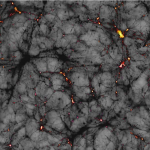Astronomers have found a nearby galaxy that’s roughly the same mass as the Milky Way, but somehow contains less than 1 percent of its stars.
The galaxy is so dim, it’s evaded detention for decades, and now the team behind its discovery has figured out how its lack of stars hasn’t ripped it apart – it’s made from 99.99 percent dark matter.
Dark matter is estimated to make up around 27 percent of all the mass and energy in the observable Universe, and while we can detect its gravitational force, it doesn’t appear to emit any form of light or radiation that we can observe.

Despite years of searching, we have no idea what dark matter actually is, but this invisible matter is crucial to the stability of the Universe.
Pieter van Dokkum, Roberto Abraham, Gemini, Sloan Digital Sky Survey
Galaxies rotate at such speeds, they’d rip themselves apart if the only thing trying to hold them together was their own gravitational force. Something else has to be holding them and the rest of the Universe together, and physicists think the answer is a whole lot of dark matter.
In fact, the standard model of cosmology suggests that there’s so much dark matter in the Universe, for every 1 gram of atoms in existence, there’s at least five times more dark matter.
Now scientists have found a galaxy that’s almost entirely made up of the stuff.
Named Dragonfly 44, the galaxy was discovered back in 2014, when a team using the WM Keck Observatory and the Gemini North Telescope in Manuakea, Hawaii, located a whole bunch of ‘fluffy galaxies’ in a region called the Coma Cluster, some 320 million light-years away.
“If the Milky Way is a sea of stars, then these newly discovered galaxies are like wisps of clouds,” one of the researchers, Pieter van Dokkum from Yale University, said at the time.
“We are beginning to form some ideas about how they were born, and it’s remarkable they have survived at all,” he added.
“They are found in a dense, violent region of space filled with dark matter and galaxies whizzing around, so we think they must be cloaked in their own invisible dark matter ‘shields’ that are protecting them from this intergalactic assault.”
Now van Dokkum and his team have had a chance to test out their hypothesis, and by figuring out the mass of Dragonfly 44, they say they have enough evidence to suggest that dark matter truly is the glue holding this whole thing together.
The researchers measured the velocities of stars in Dragonfly 44 for 33.5 hours over a period of six nights, and used this information to calculate the mass of the galaxy as a whole.
An increase in the velocity of an object will increase its kinetic energy and therefore its mass, which means the faster these stars are going will equate to a more massive galaxy.
Having measured the speed of Dragonfly 44’s stars as around 47 kilometres per second, the team calculated that it’s around 1 trillion times more massive than our Sun – far too heavy to be held together by its stars alone.
“Motions of the stars tell you how much matter there is,” van Dokkum told Avery Thompson at Popular Mechanics. “They don’t care what form the matter is, they just tell you that it’s there. Using the Keck Observatory, we found many times more mass indicated by the motions of the stars than there is mass in the stars themselves.”
Having estimated that the galaxy needs to be made up of 99.99 percent of dark matter to remain intact, the team has officially found the darkest known galaxy in the Universe.
A similarly dark galaxy in the Virgo cluster was identified earlier this year, but its 99.96 percent dark matter just got beat.
As cool as this discovery is, it’s thrown up a whole lot more questions than answers. Right now, every potential candidate for dark matter has failed to yield enough evidence to explain what it’s made from, and until recently, the only dark matter galaxies we’ve known about have been tiny.
Dragonfly 44 is huge, and no one can figure out how it got so big – and stayed so big – with so little visible matter. But at least now we’ve now got an entire galaxy full of dark matter to study, right?
“It’s hard to argue with the observations, yet the conclusion from this paper runs counter to my understanding of how galaxies are formed,” one of the team, astronomer Marla Geha from Yale University, who wasn’t involved in the research, told New Scientist.
“I’m hoping these objects are rather rare and/or only form in special environments such as a dense galaxy cluster. Otherwise we may need to rewrite galaxy formation.”
The research has been published in Astrophysical Journal Letters.





